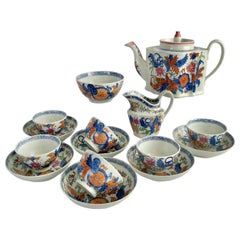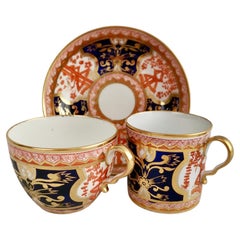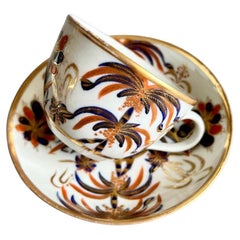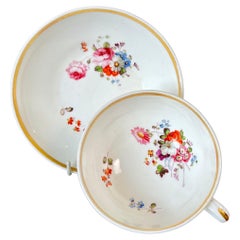Want more images or videos?
Request additional images or videos from the seller
1 of 14
New Hall Porcelain Teacup, Boy in the Window Pattern 425, Chinoiserie circa 1815
$228List Priceper set
About the Item
- Creator:New Hall (Maker)
- Dimensions:Height: 1 in (2.54 cm)Width: 1 in (2.54 cm)Depth: 1 in (2.54 cm)
- Sold As:Set of 2
- Style:Chinoiserie (Of the Period)
- Materials and Techniques:
- Place of Origin:
- Period:
- Date of Manufacture:circa 1815
- Condition:Wear consistent with age and use. In good antique condition without any damage, crazing or repairs and just a bit of wear as visible in the pictures.
- Seller Location:London, GB
- Reference Number:Seller: A-NEW181stDibs: LU4805119932252
About the Seller
5.0
Vetted Professional Seller
Every seller passes strict standards for authenticity and reliability
Established in 2016
1stDibs seller since 2019
227 sales on 1stDibs
Typical response time: 2 hours
Authenticity Guarantee
In the unlikely event there’s an issue with an item’s authenticity, contact us within 1 year for a full refund. DetailsMoney-Back Guarantee
If your item is not as described, is damaged in transit, or does not arrive, contact us within 7 days for a full refund. Details24-Hour Cancellation
You have a 24-hour grace period in which to reconsider your purchase, with no questions asked.Vetted Professional Sellers
Our world-class sellers must adhere to strict standards for service and quality, maintaining the integrity of our listings.Price-Match Guarantee
If you find that a seller listed the same item for a lower price elsewhere, we’ll match it.Trusted Global Delivery
Our best-in-class carrier network provides specialized shipping options worldwide, including custom delivery.You May Also Like
Georgian New Hall Porcelain Oval Teapot with Boy in Window Pattern 425, Ca 1802
By New Hall
Located in Lincoln, Lincolnshire
This is a hard paste porcelain tea pot and lid by New Hall dating to very early 19th century, George 111rd period, circa 1800 / 1805.
The Teapot is well potted with an oval shape and high loop handle.
The decoration is hand-painted in bold enamels in a chinoiserie pattern called "Boy or Lady in the Window" and is pattern number 425, with an upper rim dot and line border.
This is a recorded New Hall pattern.
A similar Teapot in the same shape with a different pattern is illustrated on page 112 of the book: An Anthology of British Teapots by Philip Miller & Michael Berthoud published by Micawber Publications.
The base has the pattern number 425 hand painted in burnt orange, on the inner foot rim.
Please Note : This piece has damage which is not obvious when displayed and it displays very well.
- please see item condition for details.
Overall a beautifully decorated example of an early English, Georgian Teapot...
Category
Antique Early 19th Century English Chinoiserie Ceramics
Materials
Porcelain
$350
H 6.5 in W 10.63 in D 4.82 in
12 Teacups and Saucers Minton Bone China Porcelain Haddon Hall
By Minton
Located in Paris, FR
Set of 12 teacups and with their saucers in Minton Bone China Porcelain. Famous Minton Haddon Hall model designed by John William Wadsworth (1879–19...
Category
Early 20th Century English Porcelain
Materials
Porcelain
12 Teacups and Saucers Minton Bone China Porcelain Haddon Hall
By Minton
Located in Paris, FR
Set of 12 teacups and with their saucers in Minton Bone China Porcelain. Famous Minton Haddon Hall model designed by John William Wadsworth (1879-19...
Category
Early 20th Century English Porcelain
Materials
Porcelain
$666 Sale Price / set
25% Off
H 2.76 in Dm 5.52 in
Early New Hall Porcelain Bowl Pattern hand painted in Boy in window ptn, Ca 1800
By New Hall
Located in Lincoln, Lincolnshire
This is an antique hard paste porcelain bowl made by the New Hall Porcelain Works, Shelton, Staffordshire, England, hand painted in the Boy in the Window pattern number 425, dating t...
Category
Antique Early 19th Century English Chinoiserie Porcelain
Materials
Porcelain
$329
H 2.5 in Dm 5.12 in
Antique English Shaped New Hall Porcelain Teapot Trivet
By New Hall
Located in Philadelphia, PA
A fine antique English porcelain teapot trivet.
Attributed to New Hall.
In a diamond-shaped form.
With a single red & black...
Category
Antique 18th Century English Georgian Porcelain
Materials
Porcelain
Four Antique Meissen Teacups with Saucers in Hand-Painted Porcelain
Located in København, Copenhagen
Four antique Meissen teacups with saucers in hand-painted porcelain.
Purple flowers and gold decoration.
Museum quality, approx. 1740.
The cup meas...
Category
Antique 1740s German Porcelain
Materials
Porcelain
Six Royal Copenhagen Frijsenborg Teacups with Saucers in Hand-Painted Porcelain
Located in København, Copenhagen
Six Royal Copenhagen Frijsenborg teacups with saucers in hand-painted porcelain with flowers and gold edge. 1950s.
The cup measures: 10 x 5 cm.
Sa...
Category
Vintage 1950s Danish Porcelain
Materials
Porcelain
$480 / set
H 1.97 in Dm 3.94 in
Kpm, Berlin, Five Royal Ivory Teacups with Saucers in Cream-Colored Porcelain
Located in København, Copenhagen
KPM, Berlin. Five Royal Ivory teacups with saucers in cream-colored porcelain with gold decoration.
1920s.
The cup measures: 11 x 7 cm.
Saucer diameter: 16.5 cm.
In excellent con...
Category
Vintage 1920s German Porcelain
Materials
Porcelain
$500 / set
H 2.37 in Dm 4.34 in
Three Antique Chinese Teacups in Hand-Painted Porcelain, Qian Long '1736-1795'
Located in København, Copenhagen
Three antique Chinese teacups in hand-painted porcelain. Qian Long (1736-1795).
Measures: 8.5 x 4.8 cm.
In excellent condition.
Signed.
Category
Antique 18th Century Chinese Porcelain
Materials
Porcelain
$700 / set
H 1.58 in Dm 3.15 in
Thomas Wolfe Factory Z Lion Pattern English Teacup and Saucer
Located in Bishop's Stortford, Hertfordshire
A scarce antique English Staffordshire bone china teacup and saucer hand decorated with a red lion by Thomas Wolfe (Factory Z) and dating from...
Category
Antique 1810s English George III Tea Sets
Materials
Porcelain
More From This Seller
View AllNew Hall Porcelain Tea Service, Japanese Tobacco Pattern, Georgian, circa 1795
By New Hall
Located in London, GB
This is a stunning tea service made by New Hall in circa 1795. The service is made of hybrid hard paste porcelain and decorated in a bold Chinoiserie pattern of large flower sprays. The service consists of a teapot with cover, a milk jug, a slop bowl, and six tea bowls with saucers.
This service has provenance; it came from the collection of David Redstone, the well known porcelain expert who wrote leading books on Bow and Chelsea porcelain.
The New Hall factory started as a cooperative of several Staffordshire potters making use of the porcelain license of Bristol Porcelain...
Category
Antique 1790s English George III Tea Sets
Materials
Porcelain
$2,900 / set
Free Shipping
Spode Porcelain Teacup Trio, Red Imari Dollar Pattern, Regency, ca 1810
By Spode
Located in London, GB
This is a beautiful orphaned teacup made by Spode in about 1810. It bears a lavish Japanese-inspired Imari pattern.
Spode was the great pioneer among the Georgian potters in England. Around the year 1800 he perfected the bone china recipe that has been used by British potters ever since, and he was also the leading potter behind the technique of transferware, making it possible for English potters to replace the Chinese export china, which had come to an end around that time, with their own designs. This was fundamental to a thriving industry that would last for about 150 years and provide half the world with their tableware. Spode porcelain is regarded as one of the highest quality porcelains around; for a soft-paste porcelain it is surprisingly hard and fine, and has a wonderful bright white colour.
The pattern on this can is called "Dollar" pattern, a very famous pattern that was used by English potters in the 18th and early 19th Century. It is obvious why it is called “dollar” - but its origin is less obvious! It is thought that this pattern was derived from a very old Chinese pattern depicting a tree with elaborate foliage that hides a Chinese character representing longevity or happiness. Traditionally, this went with a an image called “Taotie”, which was used on very ancient bronze vases...
Category
Antique Early 1800s English Regency Porcelain
Materials
Porcelain
New Hall Hybrid Hard Paste Teacup, Palm Tree patt. 484, Georgian ca 1810
By New Hall
Located in London, GB
This is a beautiful teacup and saucer made by New Hall around the year 1810. The set is decorated in the very desired but rare palm tree pattern with the number 484.
We also have a ...
Category
Antique 1810s English Regency Tea Sets
Materials
Porcelain
Samuel Alcock Porcelain Teacup, White with Flower Sprays, ca 1823
By Samuel Alcock & Co.
Located in London, GB
A teacup and saucer in the “half orange” shape, white with simple gilt rim and beautiful hand painted flower sprays
Pattern unknown but similar to 1082
Year: ca 1823
Size: cup diameter 10cm (4”), saucer diameter 14.2cm (5.5”)
Condition: excellent, some rubbing to gilt
There are several items available in this design, please see group image and ask for more info if interested.
The Samuel Alcock factory was operative in Staffordshire between 1822 and 1856, after which it was bought by Sir James Duke and Nephews. The factory started as a partnership between the young Samuel Alcock and the older Ralph Stevenson, who provided the factory and capital. Alcock quickly took the factory to great heights, building one of the biggest factories of its time. Alcock jumped on the new Rococo Revival fashion and served a huge new middle class market. The reason we now don't hear much about Samuel Alcock porcelain...
Category
Antique 1820s English Regency Tea Sets
Materials
Porcelain
Samuel Alcock Teacup, Pale Yellow, Gilt and Flowers, ca 1824
By Samuel Alcock & Co.
Located in London, GB
A teacup in the “melted snow” shape with double drop handles, pale yellow ground with rich gilt and cobalt blue acanthus pattern and finely painted flower reserves in centre of the t...
Category
Antique 1820s English Rococo Revival Porcelain
Materials
Porcelain
Barr Flight & Barr Teacup, Salmon with Monochrome Sepia Landscapes, ca 1810
By Barr, Flight & Barr Worcester
Located in London, GB
On offer is a very rare teacup and saucer made by Barr Flight & Barr in about 1810. The set has a beautifully soft salmon ground colour, an elegant gilt border motif, and beautiful monochrome sepia landscape...
Category
Antique 1810s English Regency Porcelain
Materials
Porcelain
$1,450 / set
Free Shipping
Recently Viewed
View AllMore Ways To Browse
English Bone China Tea Set
Grainger Worcester
Large Tea Cup
Bristol Porcelain
Silver Demitasse Set
Sterling Silver Tea Pot
Coffee Tea Set German
French Tea Cups
Silver Plated Tea Pot
Teapot Sugar Creamer
18th Century Silver Teapot
Antique Japanese Cup And Saucer Porcelain
Antique Porcelain Coffee Sets
Hand Painted Japan Tea Set
Italian Teapot
Japanese Mid Century Tea Set
Art Deco Tea And Coffee Service
Early 20th Century Teapots



